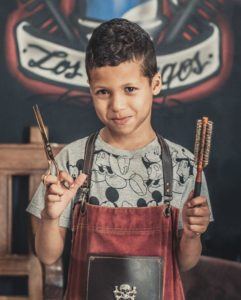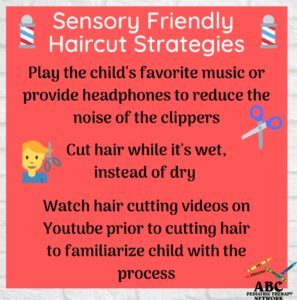Month: October 2020

Removing the fear of sight and sound of the clippers/scissors
- Slowly introduce clippers/scissors placing across the room and moving closer as tolerated
- Once tolerated nearby, slowly introduce sound by turning clippers on across the room and moving closer as tolerated
- Present preferred activity for distraction during introduction of clippers/scissors
- Utilize vibrating massager to desensitize sound of clippers
Removing the fear of the touch with clippers or hair
- Use of vibrating massager progressing from tolerating touch on extremities progressing to tolerating touch on various locations of head/neck
- Use of feathers and other items similar in texture to hair to play a game encouraging tolerating touch to different parts of the body including neck, arms, back, ears.
- Brushing protocol
- Encourage messy play
- Deep pressure/massage to scalp
Compensatory Strategies
- Use of tools to reduce noise
- Headphones or earplugs
- Preferred music
- Use of scissors if clippers can’t be tolerated
- Wet hair instead of dry
- Use of something to prevent hair from touching skin
- Visor
- Turtleneck or towel
- Clippers that collect hair
- Hairdryer to blow hair
- Showering immediately following haircut
- Use of calming strategies during task
- Weighted blanket/compression clothing
- Fidget
- Preferred activity
- Brushing protocol
Tip: allow child to have some control by providing choices with use of compensatory strategies.
Additional Strategies
- Use of social stories
- Watching videos on hair cutting
- Pretend play with dolls or stuffed animals
- Playdough hair cutting tools
- Use of rewards
- Favorite activity for distraction
- Step by step picture schedule
- Timer
- Hair cutting apps (ex: Hair Salon)
- Slow, fun, non pressured progression of steps
- Engage child in activity by giving them a job (ex: hairdryer)
Tips: establish pleasant memories of hair cutting and replace unpleasant memories and increase frequency of task to keep pleasant thoughts in recent memories

For more information, visit http://www.abcpediatrictherapy.com
Read MoreStrategies for Little Ones:
- Offer choices embedded into daily routines. This can be in ANY routine! Try offering visual options for choices of cups, shirts to wear, toys, snacks etc. This creates an opportunity for your little one to make a request by pointing, or imitation!
- Be sure to choose some time in your day to sit down and practice basic turn-taking. If Your little one is busy, it might mean they need to sit at a small table and chairs, or even their booster chair! If the toy is enticing you will sometimes be surprised how long they will attend and they will appreciate the one-on-one time with you!
- READ books. This is best incorporated into a nighttime routine “books before bed”, but books are fun at anytime of the day! Be expressive and engage with your child to see if he/she can point to named pictures and explain what is happening in each one. When the children are under the age of 2, they might only need simple, colorful picture-board books or sensory “touch and feel” books are perfect choices!
- Get silly! Be expressive when you interact, get down on the floor and PLAY! You can roll a ball, play hide-and-seek, engage with simple cause-and-effect toys, simple puzzles, pretend play activities with a baby doll, cars, or dinosaur.
- Always talk about what you are doing during each routine. The more words your little ones hear, the better. They are listening and storing up the vocabulary words, in addition this allows for expansion of their expressive vocabulary and creates opportunities for verbal imitation.
- Even bath time can be a great time to build language skills! You can work on body part identification (i.e. “Where is your belly?”) You can model words like “splash”, “pour”, “uh-oh”, “in”, “out”, “wash”, sing songs while in the bath and play with bath toys or fun bath-safe paints.
For more information, visit http://www.abcpediatrictherapy.com
Read More Skip to content
Skip to content
